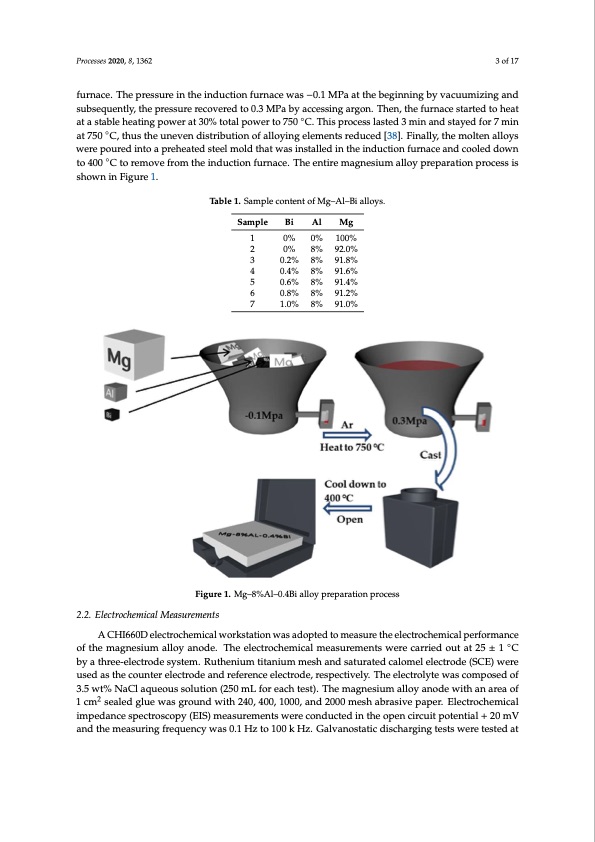
PDF Publication Title:
Text from PDF Page: 003
Processes 2020, 8, 1362 3 of 17 Processes 2020, 8, x FOR PEER REVIEW 3 of 17 furnace. The pressure in the induction furnace was −0.1 MPa at the beginning by vacuumizing and subsequently, the pressure recovered to 0.3 MPa by accessing argon. Then, the furnace started to heat subsequently, the pressure recovered to 0.3 MPa by accessing argon. Then, the furnace started to heat at a stable heating power at 30% total power to 750 ◦C. This process lasted 3 min and stayed for 7 min at a stable heating power at 30% total power to 750 °C. This process lasted 3 min and stayed for 7 min at 750 ◦C, thus the uneven distribution of alloying elements reduced [38]. Finally, the molten alloys at 750 °C, thus the uneven distribution of alloying elements reduced [38]. Finally, the molten alloys were poured into a preheated steel mold that was installed in the induction furnace and cooled down were poured into a preheated steel mold that was installed in the induction furnace and cooled down ◦ to 400 °C to remove from the induction furnace. The entire magnesium alloy preparation process is shoswhonwin iFnigFuigruer1e.1. to 400 C to remove from the induction furnace. The entire magnesium alloy preparation process is Sample 1 2 TTabablele11..SSaampllecontentofMg––Al–l–BBiiaallloloyys.s. Bi Al Mg 2.2. Electrochemical Measurements 3 0.2% 8% 91.8% 3 4 0.4% 8% 91.8% 8% 981%.6% 5 0.6% 8% 8% 8% 91.6% 8% 91.4% 6 0.8% 8% 91.2% 7 1.0% 8% 91.0% Sample Bi Al Mg 0% 0% 100% 0% 0.2% 0.4% 0.6% 0.8% 1.0% 1 0%0%100% 0% 8% 92.0% 2 8% 92.0% 5 91.4% 91.2% 6 7 91.0% 2.2. Electrochemical Measurements Figure 1. Mg–8%Al–0.4Bi alloy preparation process Figure 1. Mg–8%Al–0.4Bi alloy preparation process A CHI660D electrochemical workstation was adopted to measure the electrochemical performance A CHI660D electrochemical workstation was adopted to measure the electrochemical◦ of the magnesium alloy anode. The electrochemical measurements were carried out at 25 ± 1 C performance of the magnesium alloy anode. The electrochemical measurements were carried out at by a three-electrode system. Ruthenium titanium mesh and saturated calomel electrode (SCE) were 25 ± 1 °C by a three-electrode system. Ruthenium titanium mesh and saturated calomel electrode used as the counter electrode and reference electrode, respectively. The electrolyte was composed of (SCE) were used as the counter electrode and reference electrode, respectively. The electrolyte was 3.5 wt% NaCl aqueous solution (250 mL for each test). The magnesium alloy anode with an area of composed of 3.5 wt% NaCl aqueous solution (250 mL for each test). The magnesium alloy anode with 1cm2sealedgluew2asgroundwith240,400,1000,and2000meshabrasivepaper.Electrochemical an area of 1 cm sealed glue was ground with 240, 400, 1000, and 2000 mesh abrasive paper. impedance spectroscopy (EIS) measurements were conducted in the open circuit potential + 20 mV Electrochemical impedance spectroscopy (EIS) measurements were conducted in the open circuit andpothtenmtiaela+su2r0inmgVfraenqduethnecymweaassur0i.n1gHfrzetqoue1n0c0ykwHasz.0G.1aHlvzatnoo1s0ta0tikcHdizs.cGhalrvgainogsteastitcsdwisecrheatregsitnegd at tests were tested at current densities 30 and 120 mA/cm2, respectively. The anode utilization efficiency was acquired by calculating the theoretical weight loss and the actual weight loss in Equation (1).PDF Image | Alloy Anode for Seawater Batteries and Related Mechanisms

PDF Search Title:
Alloy Anode for Seawater Batteries and Related MechanismsOriginal File Name Searched:
processes-08-01362.pdfDIY PDF Search: Google It | Yahoo | Bing
Product and Development Focus for Salgenx
Redox Flow Battery Technology: With the advent of the new USA tax credits for producing and selling batteries ($35/kW) we are focussing on a simple flow battery using shipping containers as the modular electrolyte storage units with tax credits up to $140,000 per system. Our main focus is on the salt battery. This battery can be used for both thermal and electrical storage applications. We call it the Cogeneration Battery or Cogen Battery. One project is converting salt (brine) based water conditioners to simultaneously produce power. In addition, there are many opportunities to extract Lithium from brine (salt lakes, groundwater, and producer water).Salt water or brine are huge sources for lithium. Most of the worlds lithium is acquired from a brine source. It's even in seawater in a low concentration. Brine is also a byproduct of huge powerplants, which can now use that as an electrolyte and a huge flow battery (which allows storage at the source).We welcome any business and equipment inquiries, as well as licensing our flow battery manufacturing.| CONTACT TEL: 608-238-6001 Email: greg@salgenx.com | RSS | AMP |